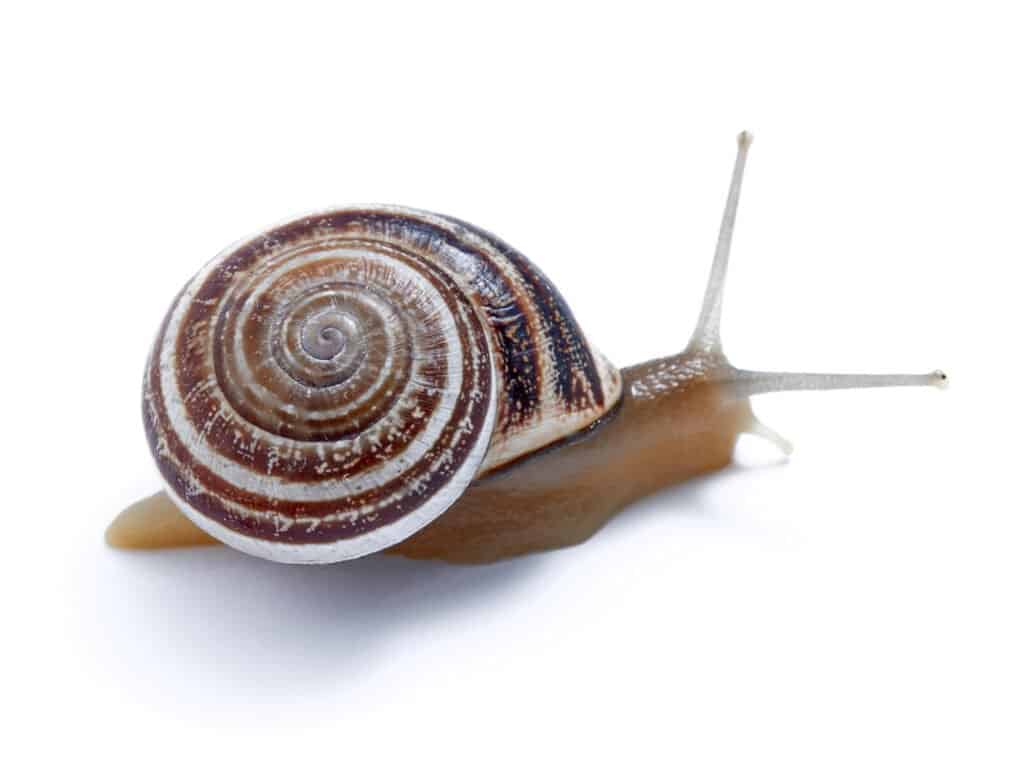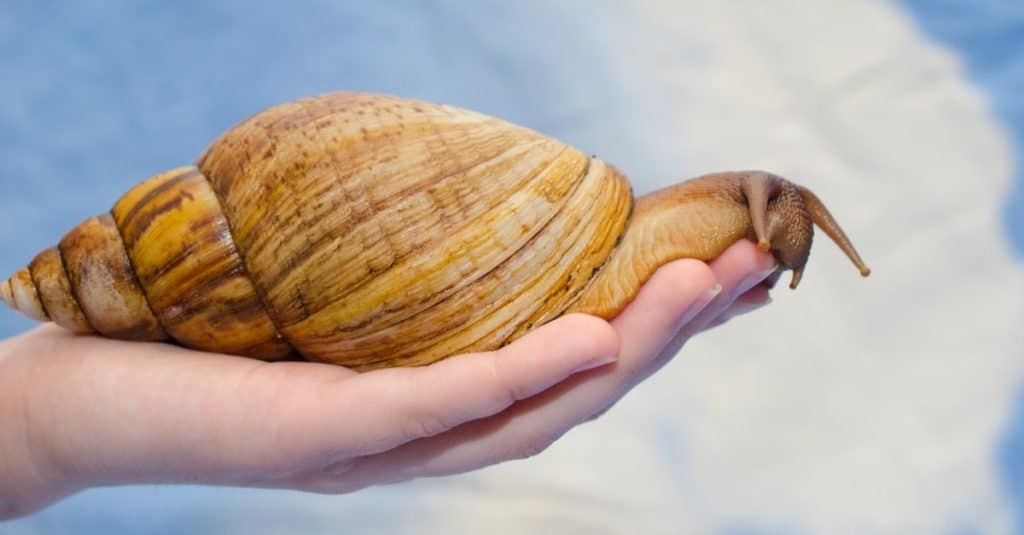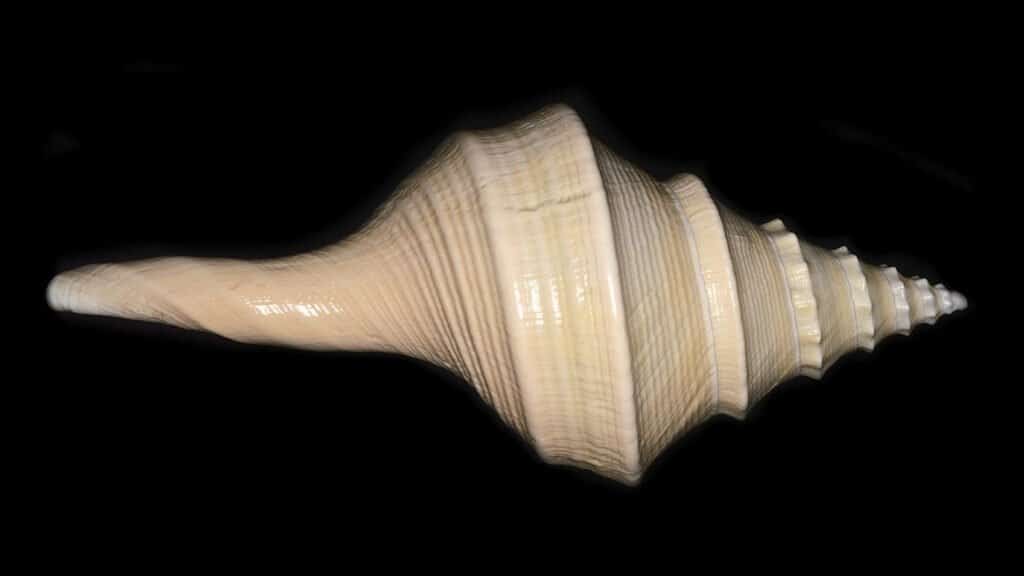The 9 Largest Snails In The World
With more than 40,000 species of snails in the world today – including land, sea, and freshwater snails – it is inevitable that there is a variety of appearances. Spread out across the world in all different habitats, from the most common of garden snails to sea snails, there is far more to snails than meets the eye. But what are the largest snails in the world? You might not expect it, but some snails can be far larger than you would ever expect. Keep reading to discover the largest snails in the world (the largest weighs more than 30 pounds)!
#9: Mediterranean Green Snail

Starting our list off at number nine is the Mediterranean Green Snail. Also called the green snail, this species is easily identifiable by its green shell and can grow to a shell size of 10-12cm (up to 5 inches) in length. Originally from the Mediterranean and parts of Europe, it is now widespread across the world as is classified as a pest due to its invasive nature and the damage that it causes to crops and vegetation.
#8: Achatina Immaculata
Achatina Immaculata is a species of snail that originated on the coast of East Africa but is now also found in South Africa as well. They are easily distinguishable by their striped shell and can grow to an adult size of 15cm (6 inches) in length. Achatina Immaculata are also often called the pink-lipped agate snail due to the stunning pink edge (lip) around the shell of most adults. These snails prefer a warm and humid environment and are often kept as pets.
#7: Apple Snails

Apple snails are a type of large freshwater snail that often grow to around 15 centimeters (6 inches) long and can be found in several different colors, including brown, blue, and yellow. They originated in South America but quickly spread around the world and became known as pests. They are particularly unique as they have both a gill and a lung which means they can survive both in and out of the water, with them often leaving the water when there is insufficient food in it for them. Apple snails are a popular pet and are often kept in fish tanks alongside fish. However, they usually eat dead fish but have also been known to feed on fish that are sick or dying if they are in the same tank as them.
Apple snails usually lay their eggs outside of the water, and they are often a vibrant pink or red colour. However, despite their appealing appearance, apple snail eggs are actually extremely harmful to the touch and contain a strong neurotoxin as well as carrying a parasite called rat lungworm.
#6: Lissachatina (Achatine) Reticulata
Lissachatina (Achatine) Reticulata are a large species of land snail and are more commonly known as “Retics”. These snails can grow extremely quickly to a size of around 18cm (7 inches) long and are found mainly in Tanzania and on the south east coast of Africa where they prefer a wet environment with a high level of humidity. They have a particularly distinctive shell as it is a different texture to most other snails, their shell having a lot of ridges and scratches on its surface. As well as these ridges, their shells can be a variety of brown, yellow and orange colors in vertical streaks.
#5: Giant African Land Snail

Olena Kurashova/Shutterstock.com
The largest land snail in the world is the giant African land snail (lissachatina fulica) which can grow to be up to 20cm (8 inches) long. These giants were originally from East Africa but are now found right across the world on every continent except for Antarctica. They have dark brown shells and they reproduce extremely quickly. They are a highly invasive species and are known as major pests as they cause so much damage to plants and crops and they spread diseases – they even carry a parasite that can cause meningitis in humans. Due to this, it is actually illegal to own them in many places and the import of them is banned in the US.
Their conservation status is Least Concern, and more information can be found on our African land snail page.
#4: Giant Whelk
Filling the top spots on the list are sea snails, and next up is is the giant whelk which is a sea snail that can grow to a shell length of around 26cm (10 inches). The giant whelk is found in the waters around Australia and Tasmania and eats crustaceans, worms, and other snails. Their shells are often fawn or an orange-brown color and they have a lot of distinctive whorls and bands on the surface.
#3: Giant Triton

The giant Triton is a large sea snail that can grow to a length of around 50 centimeters (20 inches) long. It is also often called Triton’s trumpet as the shell can be used to make a trumpet sound. They are commonly found in the Indo-Pacific oceans and are actually very important to the health of coral reefs as they are a natural predator of the highly venomous Crown-of-Thorn starfish which feed on the reefs. As well as feeding on starfish, the giant Triton also eats other snails and it hunts by chasing its prey and then paralyzing it with its saliva. Their shells are usually either white or a yellow-brown color and have a spindle-like shape.
#2: Florida Horse Conch
Triplofusus giganteus, also known as the Florida horse conch, is a sea snail that has a shell length of 60 centimeters (two feet). It is commonly found along the Atlantic Coast of the US and is the largest snail that can be found in the US waters. It prefers to live in the sand and mud flats of the relatively shallow water along the coast and eats other snails and also hermit crabs. Its shell usually has many whorls on its surface and is a distinctive orange color in youngsters that fades somewhat as the snail gets older.
#1: Australian Trumpet

Guillermo Guerao Serra/Shutterstock.com
Easily coming in at number one is the Australian Trumpet, which is a huge sea snail that is found in the waters around its native Northern Australia, and also in Eastern Indonesia and Papua New Guinea. These giants can grow to a whopping length of 91cm (3 feet) and can weigh in at around 18kgs (40 lbs)! This massive size makes the Australian Trumpet the largest snail in the world.
Their diet usually consists of marine worms but little else is known about them, however, they are often hunted for both food and for their impressive shells. The shells from the Australian trumpets are particularly unique and are highly collectable. Their shells are usually a pale color, sometimes pale yellow, and have a distinctive shape that is narrower at one end.
More from A-Z Animals
With more than 40,000 species of snails in the world today – including land, sea, and freshwater snails – it is inevitable that there is a variety of appearances. Spread out across the world in all different habitats, from the most common of garden snails to sea snails, there is far more to snails than meets the eye. But what are the largest snails in the world? You might not expect it, but some snails can be far larger than you would ever expect. Keep reading to discover the largest snails in the world (the largest weighs more than 30 pounds)!
#9: Mediterranean Green Snail

Starting our list off at number nine is the Mediterranean Green Snail. Also called the green snail, this species is easily identifiable by its green shell and can grow to a shell size of 10-12cm (up to 5 inches) in length. Originally from the Mediterranean and parts of Europe, it is now widespread across the world as is classified as a pest due to its invasive nature and the damage that it causes to crops and vegetation.
#8: Achatina Immaculata
Achatina Immaculata is a species of snail that originated on the coast of East Africa but is now also found in South Africa as well. They are easily distinguishable by their striped shell and can grow to an adult size of 15cm (6 inches) in length. Achatina Immaculata are also often called the pink-lipped agate snail due to the stunning pink edge (lip) around the shell of most adults. These snails prefer a warm and humid environment and are often kept as pets.
#7: Apple Snails

Apple snails are a type of large freshwater snail that often grow to around 15 centimeters (6 inches) long and can be found in several different colors, including brown, blue, and yellow. They originated in South America but quickly spread around the world and became known as pests. They are particularly unique as they have both a gill and a lung which means they can survive both in and out of the water, with them often leaving the water when there is insufficient food in it for them. Apple snails are a popular pet and are often kept in fish tanks alongside fish. However, they usually eat dead fish but have also been known to feed on fish that are sick or dying if they are in the same tank as them.
Apple snails usually lay their eggs outside of the water, and they are often a vibrant pink or red colour. However, despite their appealing appearance, apple snail eggs are actually extremely harmful to the touch and contain a strong neurotoxin as well as carrying a parasite called rat lungworm.
#6: Lissachatina (Achatine) Reticulata
Lissachatina (Achatine) Reticulata are a large species of land snail and are more commonly known as “Retics”. These snails can grow extremely quickly to a size of around 18cm (7 inches) long and are found mainly in Tanzania and on the south east coast of Africa where they prefer a wet environment with a high level of humidity. They have a particularly distinctive shell as it is a different texture to most other snails, their shell having a lot of ridges and scratches on its surface. As well as these ridges, their shells can be a variety of brown, yellow and orange colors in vertical streaks.
#5: Giant African Land Snail

Olena Kurashova/Shutterstock.com
The largest land snail in the world is the giant African land snail (lissachatina fulica) which can grow to be up to 20cm (8 inches) long. These giants were originally from East Africa but are now found right across the world on every continent except for Antarctica. They have dark brown shells and they reproduce extremely quickly. They are a highly invasive species and are known as major pests as they cause so much damage to plants and crops and they spread diseases – they even carry a parasite that can cause meningitis in humans. Due to this, it is actually illegal to own them in many places and the import of them is banned in the US.
Their conservation status is Least Concern, and more information can be found on our African land snail page.
#4: Giant Whelk
Filling the top spots on the list are sea snails, and next up is is the giant whelk which is a sea snail that can grow to a shell length of around 26cm (10 inches). The giant whelk is found in the waters around Australia and Tasmania and eats crustaceans, worms, and other snails. Their shells are often fawn or an orange-brown color and they have a lot of distinctive whorls and bands on the surface.
#3: Giant Triton

The giant Triton is a large sea snail that can grow to a length of around 50 centimeters (20 inches) long. It is also often called Triton’s trumpet as the shell can be used to make a trumpet sound. They are commonly found in the Indo-Pacific oceans and are actually very important to the health of coral reefs as they are a natural predator of the highly venomous Crown-of-Thorn starfish which feed on the reefs. As well as feeding on starfish, the giant Triton also eats other snails and it hunts by chasing its prey and then paralyzing it with its saliva. Their shells are usually either white or a yellow-brown color and have a spindle-like shape.
#2: Florida Horse Conch
Triplofusus giganteus, also known as the Florida horse conch, is a sea snail that has a shell length of 60 centimeters (two feet). It is commonly found along the Atlantic Coast of the US and is the largest snail that can be found in the US waters. It prefers to live in the sand and mud flats of the relatively shallow water along the coast and eats other snails and also hermit crabs. Its shell usually has many whorls on its surface and is a distinctive orange color in youngsters that fades somewhat as the snail gets older.
#1: Australian Trumpet

Guillermo Guerao Serra/Shutterstock.com
Easily coming in at number one is the Australian Trumpet, which is a huge sea snail that is found in the waters around its native Northern Australia, and also in Eastern Indonesia and Papua New Guinea. These giants can grow to a whopping length of 91cm (3 feet) and can weigh in at around 18kgs (40 lbs)! This massive size makes the Australian Trumpet the largest snail in the world.
Their diet usually consists of marine worms but little else is known about them, however, they are often hunted for both food and for their impressive shells. The shells from the Australian trumpets are particularly unique and are highly collectable. Their shells are usually a pale color, sometimes pale yellow, and have a distinctive shape that is narrower at one end.






